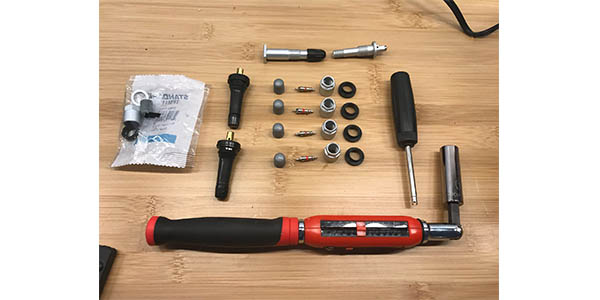
Since TPMS was made mandatory on 2008 model year and newer vehicles, TPMS service kits have become a critical part of tire and wheel service.
Anytime a tire is removed from the rim of a vehicle, a new TPMS kit must be installed. The existing sensor kit could be brand new or years old, but every tire removal should include the replacement of the TPMS sensor kit. Not replacing the kits could cause big problems with tire pressure and the vehicle’s TPMS if not properly serviced.
Due to the variety of vehicles that can come into a shop on a regular basis, shops should stock their bays with different TPMS service kits. There are services and providers that can make inventory of TPMS service kits easier for a repair facility. Not having the right kit on hand can leave a car stuck in a bay that could be used for other service jobs.
Clamp-on kits are comprised of a nut, valve core, grommets and a valve cap. Each piece has a specific function and lifespan. Meanwhile, snap-in sensors look like regular rubber valve stems and include a valve cap.
There are several reasons you should never reuse parts or sensor kits when servicing TPMS. For example, it’s critical to never reuse a valve stem. Valve stems are subjected to heat from both the brakes and road and can degrade over time.
In addition, always use the valve core included in the kit to prevent future leaks. A TPMS valve core is nickel-plated and prevents galvanic corrosion and ensures the integrity of the main seal. To help prevent corrosion, never use a brass valve core with an aluminum TPMS sensor. Instead, use a nickel-plated valve core with an aluminum TPMS sensor. If the wrong valve core is used, accelerated corrosion could result in the core becoming stuck in the stem and unable to be removed.
If a nut is reused, the anodized aluminum surface (which prevents against galvanic corrosion and material deterioration) can be scratched away. This could cause corrosion between the sensor, wheel and stem, making the nut impossible to torque to the correct specifications or remove due to corrosion on the threads.
Reusing seals and grommets can also cause problems. On the sensor, the two grommets help seal the nut to the wheel. As soon as the nut is torqued, the grommets conform to the shape of the wheel. This previous shaping can’t be fixed and reusing these pieces may cause a slow leak.
INSTALLING KITS
When removing a tire from the wheel, it’s important to locate the TPMS sensor and be careful not to damage it, which will cost the shop its profits to replace the sensor it mistakenly broke.
When it comes time to install a new TPMS sensor kit, it’s important to follow instructions or the manufacturer’s recommendations.
When installing snap-in valves, there can be two different installation methods depending on the valve stem being installed. The first installation method involves installing the valve stem in the rim and then attaching the sensor. The second method is to first attach the sensor to the valve stem, and then insert it into the wheel.
The reason for the two installation methods is due to the sensors’ contact with the wheel. Some sensors could come into contact with the wheel as the stem is pulled.
Remember to always use a preset torque screwdriver with the correct torx head, when attaching a new valve sensor to the sensor body. Many tool suppliers package two preset torque drivers in a set.
Be mindful of the stress on the sensor and its alignment when tightening the screw. Slowly screw in the threads to make sure the sensor and stem are aligned. And, stop when the tool clicks indicating the proper torque has been reached.
When tightening the screw, make sure you don’t over-tighten the nut. Sealing grommets are engineered to work at a specific torque and over tightening them can result in a leak. This is why torque specifications are measured in inch-pounds and not foot-pounds. Hollow stems can only take so much pressure before they break.














